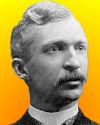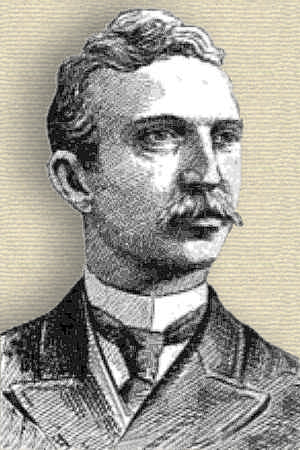 (source)
(source)
|
James Keeler
(10 Sep 1857 - 12 Aug 1900)
American astronomer who confirmed that the rings of Saturn were not solid, but composed of meteoric particles.
|
James Edward Keeler,
astronomer,

[p.498] was born at La Salle. Ill., Sep. 10, 1857, son of William F. and Anna C. (Dutton) Keeler. His father was a paymaster in the U. S. navy during the civil war and was an officer on board the original Monitor. His first American ancestor was Ralph Keeler, born in England in 1613, one of the first settlers of Hartford, Conn., in 1637, and of Norwalk in 1650. His great-grandfather, Samuel Keeler, born 1737, was an ensign in the revolutionary war, and his maternal grandfather. Henry Dutton was dean of the Yale Law School from 1847-55, judge of the supreme court and court of errors of Connecticut 1861-66, and governor of that state in 1854.
When a lad James Keeler evinced scientific tastes by experimenting in chemistry, electricity and steam engineering. He became familiar with the theory and use of small telescopes; in fact, constructed two or three himself, and no observations made in later years gave him so much delight as his first glimpse of Saturn through his 2½-inch telescope and its cedar tube.
After attending the public schools he entered Johns Hopkins University in 1877, and was graduated in 1881. While at Johns Hopkins his tastes and ambitions were stimulated in a variety of ways. Through the kindness of Charles H. Rockwell, of Tarrytown, N. Y., he was enabled to take part in the solar eclipse expedition which went to Colorado in 1878, under the direction of Prof. Holden.
In the spring of 1881, Prof. Langley (whom Mr. Keeler succeeded as director of the Allegheny Observatory) gave a series of lectures at Johns Hopkins, when he had the assistance of young Keeler. in whom he recognized a kindred spirit. Later in the season, even before his formal graduation, Mr. Keeler was enlisted by Prof. Langley in the famous Mount Whitney (California) expedition for the study of solar physics. On his return he became a regular assistant at the Allegheny Observatory.
During 1883-84 he studied under Quincke, in Heidelberg, and Von Helmholtz, in Berlin, Germany.
On his return to America, in 1886, be was appointed astronomical assistant at the Lick Observatory, then in process of construction, and on its completion, in 1888, was appointed full astronomer, with the special department of stellar spectroscopy. He also had charge of the time service. With the aid of the 36-inch telescope and the Mills spectroscope (made from Prof. Keeler's drawings) he measured spectra of stars and planets, and discovered and measured the motions of the nebulae.
Within a very short time the accuracy of his work became famous and many disputed points, like that of the precise position of the chief line in this spectrum of nebulae, over which Huggins and Lockyer disagreed, were referred to him for determination.
He abandoned his post in the Lick Observatory in 1891 to take charge of the Allegheny Observatory. Here his work was almost exclusively in the line of stellar spectroscopy, and he succeeded in getting many excellent photographs in that part of the spectrum where the rays have less actinic value than in the violet region. While here, too, he determined with the spectroscope the fact that Saturn's ling is composed of small detached meteoric particles, and pursued his investigations of the relations between the spectra of the nebulæ and stars in Orion. In March, 1898, Prof. Keeler was elected director of the Lick Observatory in place of Prof. Holden. His labors there during this period were largely of an executive nature, but he found time to continue some of his earlier investigations, giving special attention to the photography of nebulæ [p.499] with the 36-inch reflecting telescope.
He wrote extensively for the “Astrophysical Journal” and other technical publications, his articles relating principally to celestial spectroscopy and on the improvement of astronomical instruments. His most important work is “Spectroscopic Observations of Nebulas, made at Mount Hamilton, Cal., with the Thirty-six-inch Refractor of the Lick Observatory,”
Besides his A.B. from Johns Hopkins, Prof. Keeler received the degree of D.Sc. from the University of California in 1893. He was a fellow of the Royal Astronomical Society, England; an associate of the American Academy of Arts and Sciences, and co-editorof the “Astrophysical Journal.” He was married at West Feliciana, La., June 16, 1891, to Cora Slocumb, daughter of William W. Matthews, who bore him a son and a daughter. He died, Aug. 13, 1900.
- 10 Sep - short biography, births, deaths and events on date of Keeler's birth.
- James E. Keeler: Pioneer American Astrophysicist: And the Early Development of American Astrophysics, by Donald E. Osterbrock. - book suggestion.




